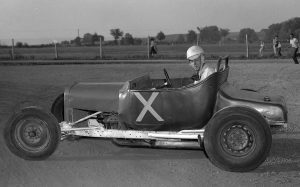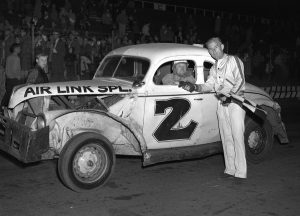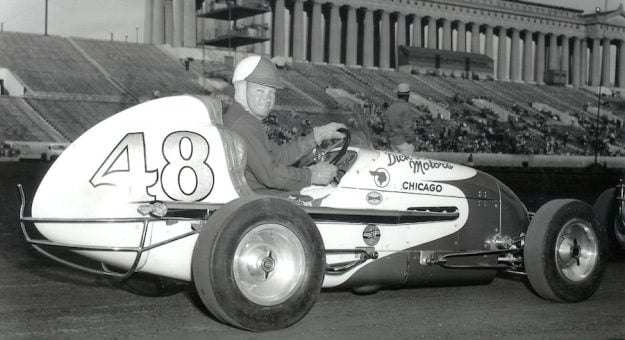During the late 1940s, midget auto racing, once the most popular form of motorsports in the United States, was in a steep decline.
Popular before World War II, midget racing took the country by storm after the war as the American populace, starved for entertainment, jammed speedways, stadiums and arenas nationwide to watch the small cars compete.
Fifth- and quarter-mile tracks, both dirt and asphalt, saw the production-built Kurtis Kraft midget with an “Offy” engine become the winning setup. It seemed like all the top drivers soon had the expensive “KK/Offy” combination, making the cars nearly equal.
After WWII, hot rod racing, featuring stripped-down cars such as 1932 Fords, etc. with souped-up engines, became a popular form of short-track racing but quickly disappeared except for a few areas throughout the country.

Enter short-track, stock car racing. Granted, stock car racing wasn’t new as it was held on larger tracks for years, but an era of weekly, at-the-same-track action was about to begin.
All across the country, the midgets began having to share their places of speed with stock cars or “hardtops” as some tracks called them. Stock cars were pretty much what everyone was driving on the streets and highways in the U.S.
The Chicago area was one of the regions the stock cars took by storm. Gill Stadium, a girls baseball field on the city’s southside, saw stock cars compete for the first time in 1948 as an added attraction to the weekly midget races there. On Labor Day 1948, the stock cars had a program of their own, as they raced around the ball diamond.
“Those early stock car races at Gill Stadium were something else,” reminisced Wayne Adams, who handled the announcing duties at Gill Stadium and “called” the first stock car events at the park.
“It all started when (hot rod car owner) Chuck Scharf and (driver) Eddy Anderson brought out about a dozen or so used cars from their used car lot and put on a little exhibition,” Adams recalled. “With mostly midget drivers handling the cars, the sport took off, with fans screaming as headlights and windshields shattered, doors got smashed and fenders were knocked off. It seemed like the fans kept screaming and cheering long after a race was over.”

In 1948, Raceway Park, south of Chicago near Blue Island, hosted two stock car programs with local open-wheel racer Danny Kladis winning a 300-lap affair in a four-wheel-drive Jeep. The tight, dirt oval had been the scene of midget racing since 1938 with the exception of the war years. During the 1948 racing season, the Championship Stock Car Club was formed.
The club oversaw weekly stock car racing at Raceway Park in 1949 and branched out to other tracks in the Midwest that were popular midget racing venues. The 16th Street Speedway in Indianapolis was one of the tracks.
Some 8,200 “standing-room-only” fans witnessed a race program at the Hoosier oval in late July. Chicago’s Bill Van Allen, who virtually drove one handed as he casually rested his left arm on the top of the door, was the feature winner that night. Another Chicago area resident, Blue Island’s Bud Koehler, who was the 1949 Raceway Park stock car and midget champion, won the evening’s “unorthodox” trophy dash — two laps forward and one in reverse.
As one local reporter put it, “It isn’t long before you know what brought most of us (to the races). It’s the crashes. It’s a dull race if it doesn’t have a tire blowout or a half-dozen bumping episodes with fenders grinding against the outer guardrail and shooting off sparks or three or four spins.”
Another reporter referred to the stock car drivers as the “bump-and-batter boys.”
Along with Van Allen and Koehler, fellow Chicago area drivers Chuck Scharf, Bryant Tucker, Bob Halston and Ed Sheeler won “hardtop” main events at 16th Street in 1949, along with Texan Pat Kirkwood and Indianapolis’ own Frank Mike.
The quarter-mile paved 16th Street oval was located across the street from Indianapolis Motor Speedway until it was torn down in 1958.
